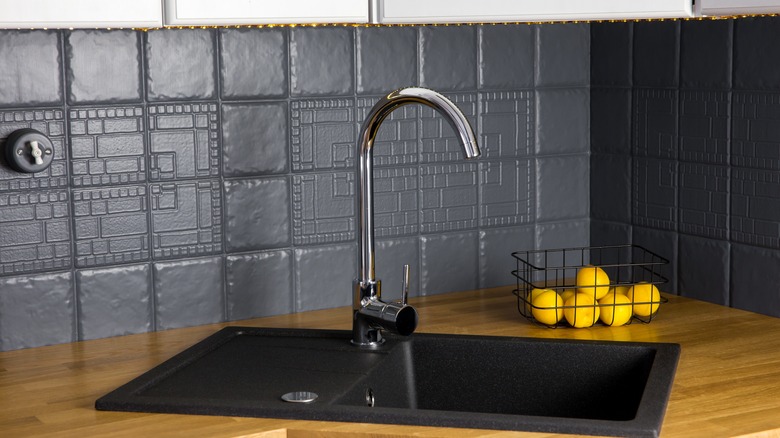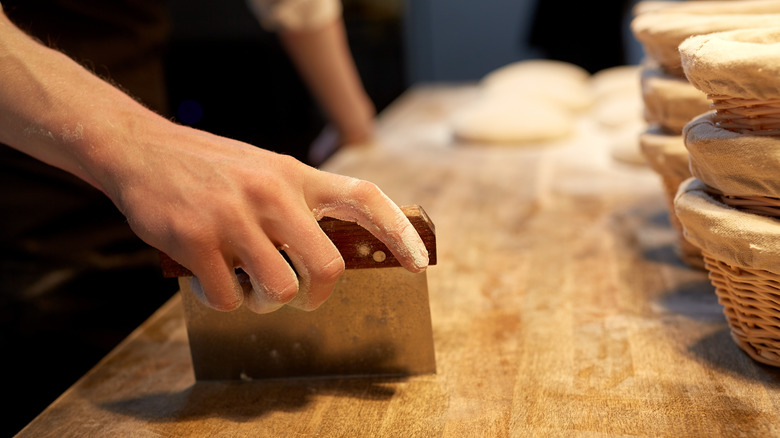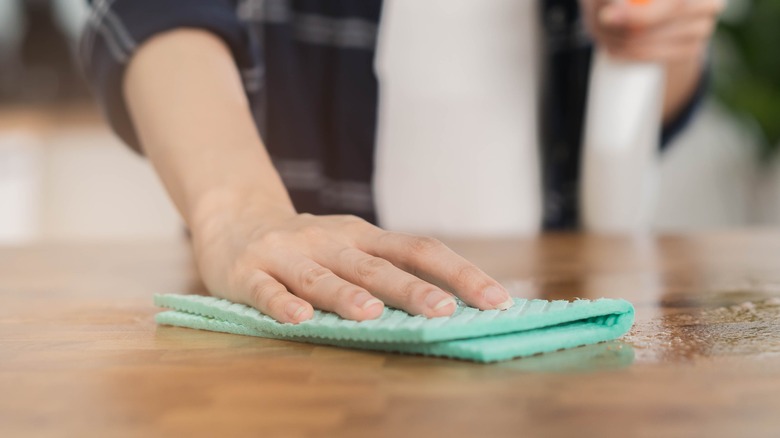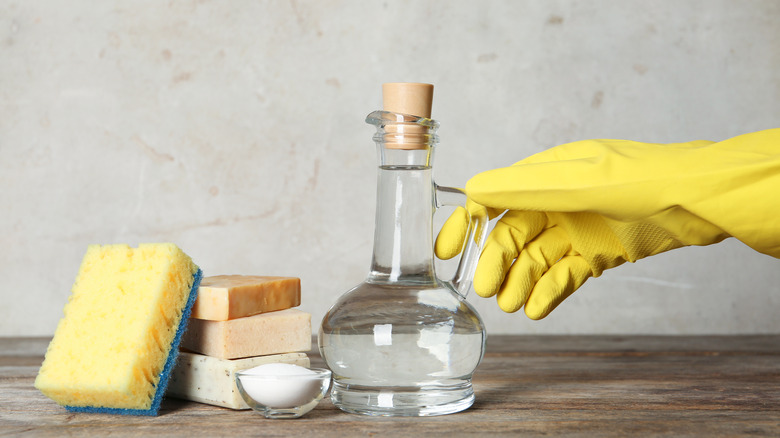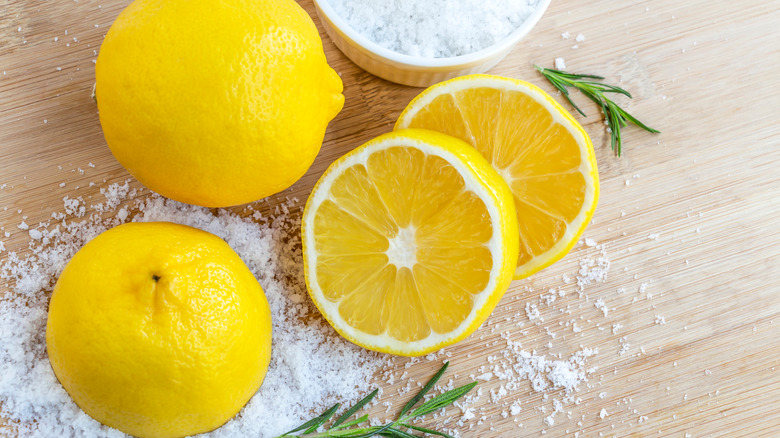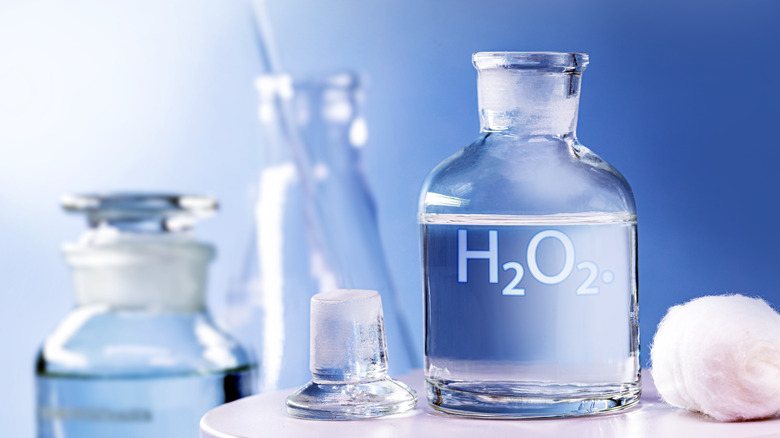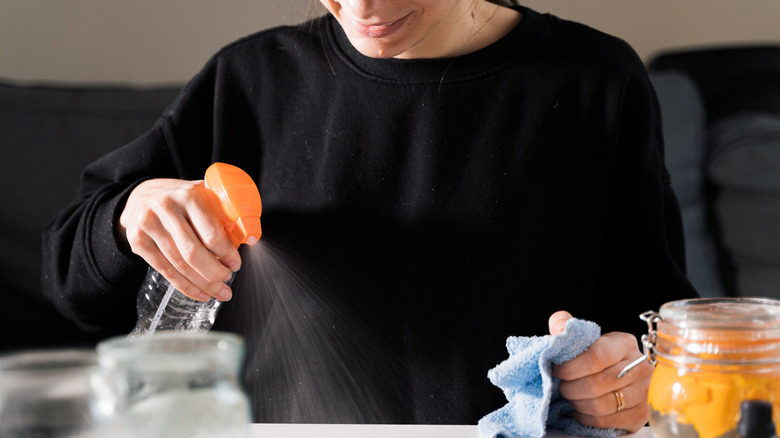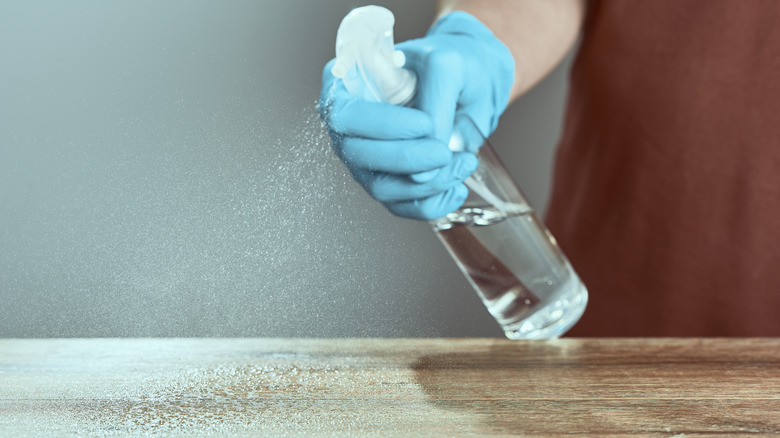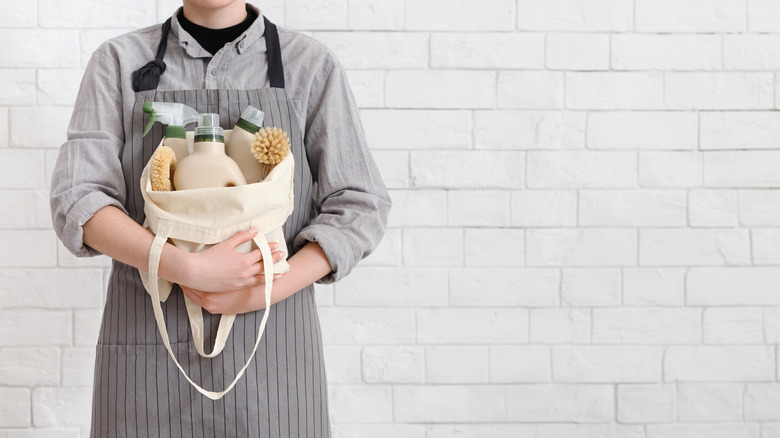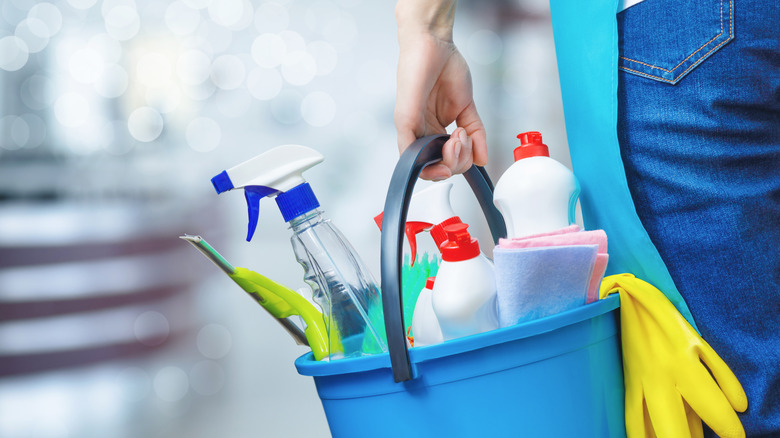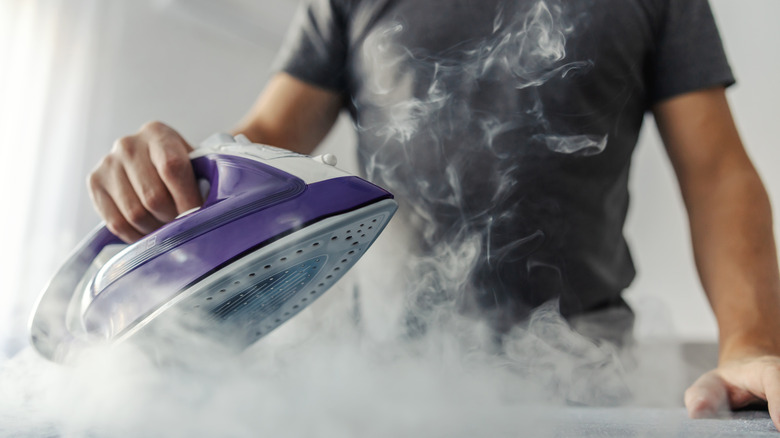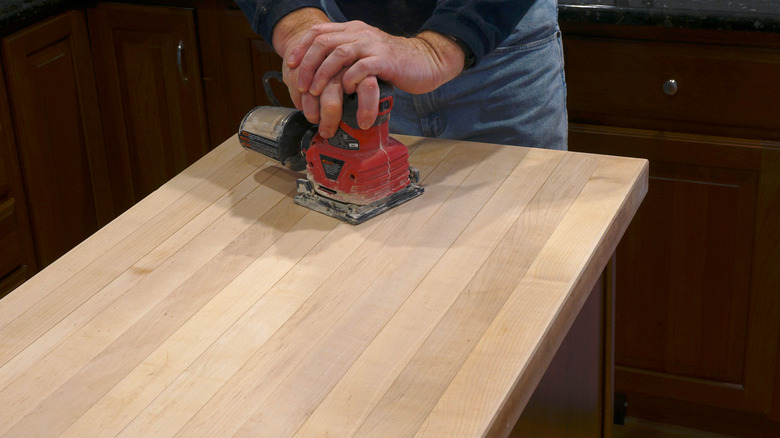How To Clean Your Solid Wood Worktops
Wood countertops aren't particularly difficult to clean, but they can certainly be more of a challenge than some stone, composite, or polymer options. They can be more easily damaged and can dry out with use and, in particular, with aggressive cleaning. Keeping the right amount of moisture in and absolutely all excess moisture out is the key to healthy butcher block (and other wood countertops) in the long term.
A conditioning step should follow almost any substantial cleaning you do to your wood worktops. This might be a light application of mineral oil, beeswax, hemp or tung or some other oil, some combination of these, or another commercially available product for wood care. The key is to get something food safe. Some products that look and smell very natural, such as Howard's Feed-N-Wax, are decidedly not safe for food prep surfaces.
You can use any of the following suggestions for cleaning, sanitizing, and stain removal, and you can also use them in any combination. We'll start with the simplest, which are often sufficient for everyday cleaning, and progress through the most aggressive options.
By the way, we're mostly talking about kitchen worktops here. If you have wood tops on furniture or counters that don't need to be food-safe, you'll likely also have finishes that have a completely different set of requirements. Also, while "butcher block" typically refers to end-grain wood surfaces, we're using it interchangeably with edge grain, since all of the cleaning processes are essentially identical.
Scraping
If your immediate counter-cleaning task is removing a bulky spill (perhaps your 13-year-old has tried making muffins, which often involves more mess than muffin), cleaning job number one might be scraping away the residue. This is only going to require a good scraper and some elbow grease, but the outcomes are limited. What you are doing at this stage is removing crusty muffin gunk so you don't end up with super-clean muffin gunk still stuck to your countertop.
There are a lot of tools you can use for this job. The most generally useful is probably a metal bench scraper, which you might have used for manipulating dough on a pastry board if you've done much baking or pasta making. There are also specialized counter scrapers and plastic "razor blades" that won't damage your counters as easily. For more aggressive scraping, including trying to remove stains after normal cleaning has failed, you can also use razor blades and card or cabinet scrapers.
How you go about this is specific to the tool, but there's not much to it. Generally speaking, with the less potentially damaging tools like a bench scraper you'll generally push the edge of the blade along the wood's grain. Don't be surprised when you remove not only yesterday's muffin gunk, but also muffin gunk from four months ago. For the more aggressive tools (which are also likely to remove a little wood), you'll pull the edge along the grain. You can certainly try pushing a razor blade, but odds are you'll end up digging into and damaging the wood.
Soap and water
To get a thorough clean that removes almost any visible dirt from your countertop, you might start with that old standby, soap and water. It takes surprisingly little soap for this to work, and you'll also need a cloth, sponge, or plastic scrubbing pad (depending on the level of soil you're dealing with).
Dampen your cloth or sponge and apply a drop of the soap of your choice; most prefer a dishwashing liquid like Dawn or a less environmentally harmful alternative. As with scraping, you'll work along the grain whenever possible, simply scrubbing well. You probably shouldn't use a scrubbing pad on wood countertops, but if you do, proceed with caution so as not to damage your wood. Then either thoroughly rinse and wring out your cloth or use a clean cloth to "rinse" away the soap residue by wiping the surface down. This might take a few passes.
At this point, you might be wondering if this approach to cleaning is, well, enough cleaning. It probably is. Despite ambient mythology about bacteria hiding in wood surfaces from time to time, a UC-Davis study of wood and plastic cutting boards found that wood is less likely to harbor bacteria than plastic and that wood is, in fact, antibacterial to some degree. Just to be clear: you should not be using your wood worktop as a cutting board; but any normal contaminants, like liquids from chicken, that you spill on wood should be reasonably safe after a light cleaning and drying.
Vinegar and water
Many people are averse to using soap or cleaning products where they prepare food, especially if the area can't be directly and thoroughly rinsed clean of residue. The good news is that there are a handful of natural cleaning approaches that are even more effective than soap and water. A simple solution of vinegar and water is one of the more popular of these.
It can be even more effective to start with undiluted vinegar by spraying down your countertops with it and letting it sit for a few minutes. This allows any antibacterial activity to get a head start, and will help in softening up any more stubborn grime. Most of the time, all that's required after that is wiping down with a clean, damp cloth. If you have particularly stubborn muffin muck, a light scrubbing might be called for, then wiping/rinsing.
Whether you use soap or vinegar, you must remember to condition your worktop with whatever food-safe oil or wax you prefer, as the protective oils will have been stripped away by use and cleaning.
Salt and lemon juice (and baking soda)
You can substitute lemon juice for vinegar in the previous step and achieve essentially the same results. A more aggressive natural cleaner builds on this approach by combining lemon juice and salt. You'll mix the lemon juice and salt in a roughly 2:1 ratio to form a cleaning paste. This can be done in a small bowl or ramekin, or you can simply sprinkle your worktop with salt, add lemon juice, and make your paste in situ right there on the wood. Since one isn't much more difficult than the other, and there's presumably some cleaning and antibacterial benefits to pre-soaking your surface, why not save the dirty bowl and apply your ingredients directly to the wood?
Beyond that, all that's required is a little scrubbing. Scrub as lightly as you can while still removing any visible soiling. Give areas with actual stains more aggressive attention; you don't want to scrub your entire countertop as aggressively as you will the stained areas. You can spot clean with a scrubbing bad or stiff-bristled brush where necessary, but don't get carried away. There are less damaging (or, at least, damaging in an easier-to-fix way) methods for handling stains.
You can repeat this step using baking soda and water instead of salt and lemon juice if you have stubbornly muffin-battered areas. You probably won't find this necessary very often, and if you do you should probably have a sit-down chat about it with your muffin chef.
Hydrogen peroxide
When you need to sanitize your work surfaces, you can start considering the use of chemicals. The best chemical to start with is hydrogen peroxide, which is available in food-safe concentrations and is considered perfectly safe for repeated application when cleaning food prep surfaces. Hydrogen peroxide is particularly effective at removing stains from wood, but is also useful as an everyday cleaner.
You basically handle 3% hydrogen peroxide as you would vinegar. Apply it straight or diluted to your countertop, then allow it to sit and work for a few minutes. Then simply wipe it off with a clean, damp cloth. You can also use hydrogen peroxide combined with baking soda in a cleaning paste. We've found this combination to be about as effective as some very successful commercial products.
Hydrogen peroxide occasionally makes some people nervous, and some research like a study by the Uiversity of Saskatchewan indicates there are reasons to be concerned when you're cleaning a large area with a lot of the chemical, so take that into consideration. Researchers say any resulting irritation is most likely to occur in cleaning professionals who are repeatedly exposed to hydrogen peroxide.
Lemon juice, water and hydrogen peroxide
If hydrogen peroxide makes you a little nervous, you can dilute it with lemon juice and water to achieve equal or even better results. Mix 2 cups of water, a cup of hydrogen peroxide, and ½ cup of lemon juice. Beyond that, it's the same routine: apply the solution, let it sit for a few minutes, scrub lightly, and wipe down with a clean, damp cloth.
Note that combining vinegar and hydrogen peroxide creates paracetic acid, which can be irritating or even dangerous in some circumstances. If you're determined to use both, you can alternate, being sure to dry your countertop between each application.
Hydrogen peroxide does have significant bleaching properties, so it's always a good idea to test your homemade cleaner on a spot to make sure it's not going to do more than you want. The properties that make it a great stain removed also make it a little bit of a risk.
Bleach and water
If you are concerned about bleaching your wood countertops, it probably goes without saying that you might want to avoid bleach. A solution of bleach and water is a fairly common cleaning solution, especially in the kitchen and bathroom, and it is effective, to be sure. It is most effective on stains that can't be removed any other way. But it can also permanently discolor your countertop.
According to butcher block counter manufacturer McClure Table, bleach should be a last resort, and if you're forced into that position, they have a recommended method of using bleach on butcher block. Create a 1:1 solution of bleach and water and soak a rag or sponge in it. Cover the stain you're dealing with completely with the rag, making sure it's making contact with the countertop at every point, and let it soak. For extreme stains, you might need to soak overnight. The key to minimizing the risk to your countertops is the final step: After the soaking is done, apply a solution of water and a couple tablespoons of baking soda to the countertop to neutralize the bleach and halt any further risk of bleaching.
With strong acids and bases like vinegar, lemon juice, and bleach, it's more important than ever to properly condition and seal your countertops after you use them.
Using non-toxic cleaning products
There are lots of commercially available products you can clean your wood countertops with, both all-purpose cleaners and wood-specific formulations. Mrs. Meyer's, Method, Howard's, and many other companies make reputable and popular nontoxic food-safe products for cleaning wood worktops. Some products, however, claim to work even better than dish soap, and these might be worth considering, but keep in mind that it could be hard to suss out which products are, in fact, that good. Gaming review systems is rampant, supplying positive reviews has become a marketing industry segment, and even wholly organic reviews are naturally polarized and, therefore, less useful than they seem.
Recommendations from people you trust are always a good approach, and here's another trick: if a manufacturer of natural cleaning products recommends other products in addition to its own, those might all be worth considering. For example, Grove Collaborative recommends six natural products... three of its own and three others, including Mrs. Meyer's, Method, and Aunt Fannie's.
But, there's a story as old as time that applies here: these products probably won't work much better than the vinegar, lemon juice, salt, and hydrogen peroxide you already have around your house. But you'll be caring for your wood countertops for years to come, so why not experiment now and then?
Using more aggressive chemical cleaners
Ironically, most experts advise that you not use your butcher block countertop for cutting meat directly, instead opting for a cutting board that can be more easily sanitized. But bacteria will congregate on your countertop either way, and you might find yourself in a situation in which you feel it's necessary to use more powerful chemicals to sanitize your countertop.
Castile soaps are a popular option. Technically made from olive oil, many products marketed as "castile soap" are made from olive, coconut, hemp, and other oils. As soaps have a tendency to leave soap scum, especially when you have hard water, it might be necessary to look for other options. Other cleaners might be based on citrus or essential oils. The "food safe" requirement limits the field quite a bit, and you should be sure that's what you're getting. A "natural" floor cleaner or furniture cleaner will almost certainly not be food safe.
Iron and clean cloth
Beyond cleaning, sometimes removing stains becomes your priority when spiffing up your countertops. Many of the methods mentioned above will work, but there are also a couple of mechanical cleaning methods that you can try. A novel but effective way to approach this is to basically attempt to wick the stain away by ironing a clean cloth directly on the stained area.
To do this, remove any water from your iron and iron the stain through a thin, clean cloth. It's that simple. This is reportedly particularly effective on water stains.
Your iron is also useful in another situation: if your wood worktop has been dented, you can give this a try. First, sand the area of the dent lightly along the wood's grain. Then moisten and fold a washcloth, towel, or other fairly thick cloth and place it over the dent. Place your iron on top of the cloth at the highest heat setting. Keep the iron moving until all of the water has dried, and keep a watch on your wood... it is possible to scorch it with this method. Remove the cloth and voila, no dent! Or less dent, perhaps.
Sanding
A more common way to remove stains is sanding, but this should be considered a last resort as it will require you to re-finish and reseal your countertops.
Use a ⅓-sheet or other rectangular power sander, as they are less likely to cause damage than a circular orbital sander. With a coarse grade of sandpaper, work the area gently, not attempting to sand away the entire stain. Finish by sanding with your countertop's grain, to remove any visible scratches. If the result does not sufficiently rid your worktop of its stains, it might be necessary to sand more aggressively, which means sanding and refinishing the whole countertop.
And don't forget, as always, to apply the food-safe wood conditioner or oil of your choice when you're done, and seal the countertop. With sanding more than any other method, you're removing the old sealant and oils, so it's most important to reapply them when you're done to protect your wood countertop.
